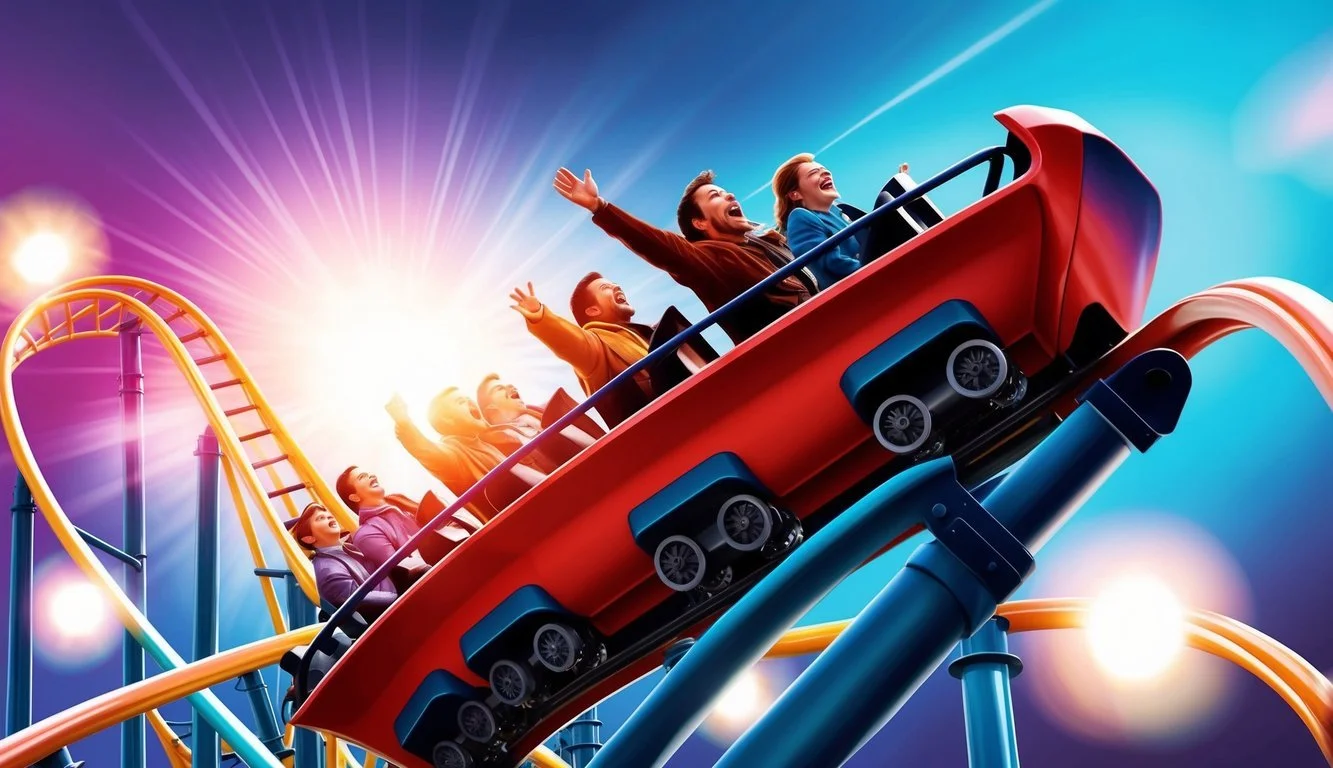Impulsivity and Sensation Seeking: The Dynamic Duo of Human Behavior
Impulsivity and sensation seeking are distinct but related personality traits that influence human behavior and decision-making. These characteristics play significant roles in how individuals approach risks, seek novel experiences, and navigate their environments.
Impulsivity refers to the tendency to act quickly without forethought or consideration of consequences, while sensation seeking involves the pursuit of varied, novel, and intense sensations and experiences. Both traits can manifest in various aspects of life, from everyday choices to more significant life decisions.
While often associated with risky behaviors, impulsivity and sensation seeking can also contribute positively to creativity, exploration, and personal growth. Understanding these traits helps shed light on individual differences in behavior, motivation, and psychological well-being across different life stages.
The Psychology of Impulsivity
Impulsivity is a complex psychological trait characterized by rapid, unplanned reactions without regard for consequences. It plays a significant role in decision-making processes and behavior patterns.
Defining Impulsivity
Impulsivity refers to the tendency to act on immediate urges without considering long-term effects. It involves difficulty in controlling responses and a lack of forethought. Impulsive individuals often struggle with patience and exhibit poor planning skills.
Psychologists categorize impulsivity into several subtypes:
Motor impulsivity: Acting without thinking
Attentional impulsivity: Difficulty focusing or shifting attention
Non-planning impulsivity: Lack of future orientation
These subtypes help researchers and clinicians better understand and address impulsive behaviors in various contexts.
Neurological Underpinnings
The brain's prefrontal cortex plays a crucial role in impulse control. This region is responsible for executive functions, including decision-making and behavior regulation. Neurotransmitters like dopamine and serotonin also influence impulsivity levels.
Brain imaging studies have revealed differences in neural activity between highly impulsive individuals and those with better impulse control. Impulsive people often show reduced activation in areas associated with self-control and increased activity in reward-seeking regions.
Genetic factors contribute to impulsivity as well. Research has identified specific genes linked to impulsive traits, suggesting a hereditary component to this psychological characteristic.
Impulsivity and Behavior
Impulsivity significantly impacts various aspects of human behavior. It can lead to both positive and negative outcomes depending on the context.
In decision-making, impulsive individuals tend to:
Choose immediate rewards over long-term benefits
Take risks without fully considering consequences
React quickly to emotional stimuli
These tendencies can manifest in problematic behaviors such as:
Substance abuse
Gambling addiction
Aggressive outbursts
Poor financial management
However, impulsivity can also drive creativity and spontaneity in certain situations. Some professions, like emergency responders or creative artists, may benefit from quick thinking and action.
Understanding impulsivity helps psychologists develop targeted interventions for impulse control disorders and improve overall behavioral management strategies.
The Thrill of Sensation Seeking
Sensation seeking drives individuals to pursue novel and intense experiences. This trait influences behavior, risk-taking, and psychological well-being in complex ways.
Understanding Sensation Seeking
Sensation seeking refers to the tendency to seek out varied, novel, complex, and intense sensations and experiences. People high in this trait crave stimulation and are willing to take risks to obtain it. They often engage in activities like extreme sports, adventure travel, or consuming intense media content.
Sensation seekers tend to have a higher tolerance for ambiguity and chaos. They may become easily bored with routine and seek constant excitement. This trait can manifest in both positive and negative behaviors, from creative pursuits to substance abuse.
Biological Basis of Sensation Seeking
Research suggests sensation seeking has a strong genetic component. Brain chemistry plays a key role, particularly the neurotransmitter dopamine. Sensation seekers may have lower baseline levels of dopamine, driving them to seek stimulation.
The prefrontal cortex and limbic system are involved in sensation seeking behaviors. These brain regions regulate impulse control, reward processing, and emotional responses. Differences in brain structure and function may contribute to individual variations in sensation seeking tendencies.
Age and gender also influence sensation seeking. The trait typically peaks in adolescence and early adulthood, then declines with age. Males generally score higher on sensation seeking measures than females.
Sensation Seeking and Risk Taking
Sensation seeking is closely linked to risk-taking behaviors. High sensation seekers are more likely to engage in dangerous activities, experiment with drugs, or make risky financial decisions. They tend to underestimate potential negative consequences and focus on the thrill of the experience.
However, not all risk-taking is harmful. Sensation seeking can drive positive outcomes like entrepreneurship, scientific discovery, and artistic innovation. The key lies in channeling this trait into constructive pursuits.
Sensation seeking also influences decision-making in everyday life. High sensation seekers may prefer fast-paced work environments, seek out novel social experiences, or constantly pursue new hobbies and interests.
Comparative Analysis of Impulsivity and Sensation Seeking
Impulsivity and sensation seeking are related but distinct personality traits that influence behavior and decision-making. Both traits can lead individuals to engage in risky activities, but they operate through different psychological mechanisms.
Impulsivity is characterized by a tendency to act without forethought or consideration of consequences. It often manifests as difficulty controlling impulses, making hasty decisions, and struggling with delayed gratification.
Sensation seeking, on the other hand, involves actively pursuing novel, varied, and intense experiences. Sensation seekers are drawn to excitement and are willing to take risks to achieve stimulation.
Key differences between impulsivity and sensation seeking:
Motivation: Impulsivity is reactive, while sensation seeking is proactive
Planning: Impulsive acts are spontaneous; sensation seeking may involve planning
Risk perception: Impulsive individuals often underestimate risks; sensation seekers are aware of risks but find them appealing
Research suggests these traits have different impacts on well-being. Impulsivity is generally associated with negative outcomes. Sensation seeking, however, may have both positive and negative effects depending on how it's expressed.
Genetic studies indicate both traits are heritable and may serve as endophenotypes for antisocial behavior. This means they could represent intermediate factors between genes and complex behavioral outcomes.
Understanding the nuances between impulsivity and sensation seeking is crucial for accurately assessing risk factors and developing targeted interventions for maladaptive behaviors.
Measurement and Assessment
Accurately measuring impulsivity and sensation seeking requires specialized assessment tools. These instruments evaluate different facets of these traits through questionnaires, behavioral tasks, and other methods. Careful consideration of validity and reliability is essential when selecting and interpreting these measures.
Assessment Tools for Impulsivity
The UPPS-P Impulsive Behavior Scale is a widely used self-report measure of impulsivity. It assesses five facets: negative urgency, lack of premeditation, lack of perseverance, sensation seeking, and positive urgency. Another common tool is the Barratt Impulsiveness Scale (BIS-11), which measures attentional, motor, and non-planning impulsiveness.
Behavioral tasks also play a crucial role in impulsivity assessment. The Stop Signal Task evaluates response inhibition by requiring participants to quickly stop a planned action. The Iowa Gambling Task assesses decision-making and risk-taking behaviors.
For children and adolescents, the Conners' Rating Scales are frequently used to assess impulsivity and related symptoms of attention-deficit/hyperactivity disorder (ADHD).
Assessment Tools for Sensation Seeking
The Sensation Seeking Scale (SSS) is a prominent measure in this field. It evaluates four dimensions: thrill and adventure seeking, experience seeking, disinhibition, and boredom susceptibility. The scale comes in various versions, including the SSS-V, which is widely used in research.
The UPPS-P scale, mentioned earlier, includes a sensation seeking subscale. This allows for a simultaneous assessment of both impulsivity and sensation seeking traits.
The Arnett Inventory of Sensation Seeking (AISS) is another valuable tool. It focuses on novelty and intensity of stimulation, making it particularly useful for adolescent populations.
Behavioral measures like the Balloon Analogue Risk Task (BART) assess risk-taking tendencies related to sensation seeking.
Validity and Reliability Issues
When using impulsivity and sensation seeking measures, researchers must consider validity and reliability. Construct validity ensures the test accurately measures the intended trait. For example, the UPPS-P scale has shown good construct validity across various populations.
Test-retest reliability is crucial for longitudinal studies. The BIS-11 has demonstrated acceptable test-retest reliability over time. However, some behavioral tasks may show practice effects, potentially impacting reliability in repeated assessments.
Cross-cultural validity is another important consideration. Measures developed in Western contexts may not accurately capture impulsivity or sensation seeking in other cultures. Researchers should use culturally adapted versions when available.
Self-report measures may be subject to social desirability bias, particularly when assessing potentially stigmatized traits. Using multiple assessment methods can help mitigate this issue and provide a more comprehensive picture of an individual's impulsivity and sensation seeking tendencies.
Impulsive and Sensation Seeking Behaviors in Different Populations
Impulsivity and sensation seeking manifest differently across age groups and cultures. These traits influence risk-taking behaviors and psychological well-being in varying ways depending on developmental stage and societal context.
Age-Related Patterns
Adolescents typically exhibit higher levels of sensation seeking compared to children and adults. This peaks in late adolescence and early adulthood, often leading to increased risk-taking behaviors during this period. Impulsivity, on the other hand, tends to decrease steadily from childhood through adulthood.
Brain development plays a crucial role in these patterns. The prefrontal cortex, responsible for impulse control, matures later than the limbic system, which drives reward-seeking behavior. This mismatch contributes to the heightened risk-taking observed in teenagers.
Older adults generally show lower levels of both impulsivity and sensation seeking. This decline is associated with increased emotional regulation and life experience.
Cultural Considerations
Cultural norms and values significantly impact the expression and acceptance of impulsive and sensation-seeking behaviors. Western individualistic cultures often view some degree of these traits as positive, associating them with creativity and entrepreneurship.
Collectivist societies, in contrast, may discourage impulsivity and sensation seeking, prioritizing group harmony and traditional values. This can lead to lower observed levels of these traits in such cultures.
Socioeconomic factors also influence these behaviors. Resource-scarce environments may foster more impulsive decision-making, while stable, affluent settings might allow for more planned, less risky choices.
Gender roles and expectations vary across cultures, affecting how impulsivity and sensation seeking are expressed and perceived in men and women.
Consequences and Implications
Impulsivity and sensation seeking behaviors can profoundly shape individuals' lives and impact society. These traits influence decision-making, risk-taking, and personal development in significant ways.
Impact on Individual Lives
Impulsive and sensation-seeking behaviors often lead to both positive and negative outcomes. On the positive side, these traits can fuel creativity, innovation, and personal growth. Individuals may pursue exciting careers, travel extensively, or engage in thrilling hobbies.
However, these behaviors also carry risks. Impulsive decisions can result in financial troubles, damaged relationships, or legal issues. Sensation seekers may engage in dangerous activities, increasing their likelihood of accidents or injuries.
Academic and professional performance can suffer due to lack of focus or prioritizing excitement over responsibilities. Some individuals struggle with substance abuse or addiction as they chase new thrills.
Social and Economic Implications
Society benefits from impulsivity and sensation seeking in certain contexts. These traits drive entrepreneurship, scientific discovery, and artistic expression. Bold risk-takers often become leaders and innovators in their fields.
Economically, industries like extreme sports, entertainment, and tourism thrive on catering to sensation seekers. However, impulsive behaviors can strain healthcare and legal systems. Risky activities may lead to increased accidents and injuries, burdening emergency services.
Financial markets experience volatility partly due to impulsive trading behaviors. Insurance premiums may rise to account for high-risk individuals. Social costs include relationship instability and potential family disruptions.
Managing Impulsive and Sensation Seeking Behaviors
Effective management of these traits involves channeling them positively while mitigating risks. Cognitive-behavioral therapy can help individuals recognize and control impulsive urges. Mindfulness practices improve self-awareness and decision-making.
Healthy outlets for sensation seeking include regulated extreme sports, travel, or creative pursuits. Setting clear goals and establishing routines can provide structure for impulsive individuals.
Education plays a crucial role in helping people understand their tendencies and potential consequences. Support systems, including family and mentors, offer guidance and accountability.
For some, medication may be necessary to manage underlying conditions like ADHD. Regular exercise and engaging hobbies can satisfy the need for stimulation in safer ways.
Therapeutic Interventions and Strategies
Cognitive-behavioral therapy (CBT) is a cornerstone treatment for impulsivity and sensation-seeking behaviors. This approach helps individuals identify triggers and develop coping mechanisms.
Mindfulness techniques play a crucial role in managing impulsive tendencies. Practices like meditation and deep breathing exercises can increase self-awareness and impulse control.
Skill-building exercises focus on enhancing decision-making abilities. These may include role-playing scenarios and problem-solving tasks to practice thoughtful responses.
Medication can be beneficial in some cases, particularly for individuals with underlying conditions like ADHD. Stimulants or non-stimulant medications may help regulate impulse control.
Family therapy and systemic interventions recognize the impact of relationships on behavior. These approaches involve family members in the treatment process to create a supportive environment.
Goal-setting using the SMART criteria (Specific, Measurable, Achievable, Relevant, Time-bound) can be effective. For example:
Reduce impulsive spending by 50% within 3 months
Practice mindfulness for 10 minutes daily for 4 weeks
Delay gratification in 3 out of 5 situations per week
Behavioral strategies like reward systems and contingency management can reinforce positive changes. These techniques provide tangible incentives for controlling impulsive behaviors.
Therapy may also address underlying issues such as stress, anxiety, or past traumas that contribute to impulsivity. Resolving these factors can lead to improved self-control.
The Role of Impulsivity and Sensation Seeking in Innovation and Creativity
Impulsivity and sensation seeking play significant roles in fostering innovation and creativity. These traits drive individuals to explore new ideas and experiences, often leading to novel insights and solutions.
Impulsivity contributes to the rapid generation of ideas. People who act on sudden impulses may produce a higher volume of creative thoughts, even if not all are viable.
Sensation seeking fuels the desire for novelty. This trait pushes individuals to seek out diverse experiences and information, broadening their perspective and knowledge base.
The neural basis for impulsivity and creativity appears to overlap. Both rely on the ability to quickly generate and act on novel ideas or impulses.
Dopamine, a key neurotransmitter, is involved in both impulsivity and creativity. It influences reward processing, motivation, and novelty-seeking behaviors.
Key benefits of novelty seeking in creativity:
Exposure to diverse perspectives
Unique connections between ideas
Enhanced problem-solving abilities
Impulsivity and sensation seeking can lead to:
Rapid ideation
Unconventional thinking
Willingness to take creative risks
While these traits can boost creativity, they must be balanced with focus and discipline to transform ideas into tangible innovations.
Future Directions in Research
Longitudinal studies tracking the development of impulsivity and sensation seeking from childhood through adulthood could provide valuable insights. These studies may reveal how these traits evolve over time and interact with environmental factors.
Neuroimaging research focusing on the neural correlates of impulsivity and sensation seeking could enhance our understanding of their biological underpinnings. This may lead to more targeted interventions for related behavioral issues.
Investigating cultural differences in the expression and perception of impulsivity and sensation seeking traits could yield important cross-cultural insights. Such research may uncover how societal norms influence these characteristics.
Exploring the relationship between impulsivity, sensation seeking, and decision-making processes in various contexts could have practical applications. This might include studies on consumer behavior, risk-taking in financial markets, or career choices.
Examining the potential positive aspects of impulsivity and sensation seeking could provide a more balanced perspective. Research into how these traits might contribute to creativity, innovation, or leadership could be particularly enlightening.
Developing more refined measurement tools to distinguish between different facets of impulsivity and sensation seeking would improve research accuracy. This could include creating scales that better capture the nuances of these multidimensional constructs.







